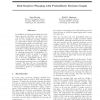Free Online Productivity Tools
i2Speak
i2Symbol
i2OCR
iTex2Img
iWeb2Print
iWeb2Shot
i2Type
iPdf2Split
iPdf2Merge
i2Bopomofo
i2Arabic
i2Style
i2Image
i2PDF
iLatex2Rtf
Sci2ools
KR
1994
Springer
1994
Springer
Risk-Sensitive Planning with Probabilistic Decision Graphs
Probabilistic AI planning methods that minimize expected execution cost have a neutral attitude towards risk. We demonstrate how one can transform planning problems for risk-sensitive agents into equivalent ones for risk-neutral agents provided that exponential utility functions are used. The transformed planning problems can then be solved with these existing AI planning methods. To demonstrate our ideas, we use a probabilistic planning framework probabilistic decision graphs" that can easily be mapped into Markov decision problems. It allows one to describe probabilistic e ects of actions, actions with di erent costs resource consumption, and goal states with di erent rewards. We show the use of probabilistic decision graphs for nding optimal plans for risk-sensitive agents in a stochastic blocksworld domain.
AI Planning Methods | Automated Reasoning | KR 1994 | Planning Problems | Probabilistic Decision Graphs |
| Added | 10 Aug 2010 |
| Updated | 10 Aug 2010 |
| Type | Conference |
| Year | 1994 |
| Where | KR |
| Authors | Sven Koenig, Reid G. Simmons |
Comments (0)

